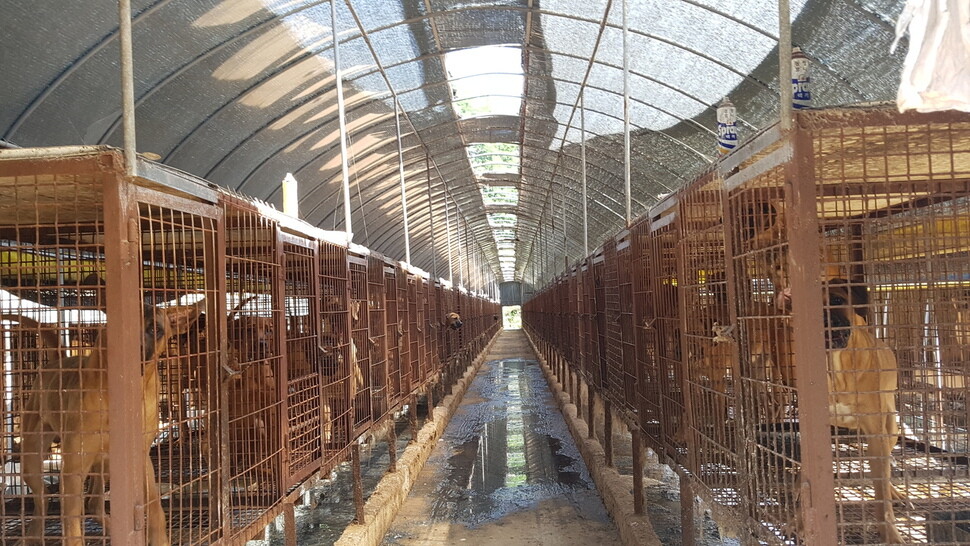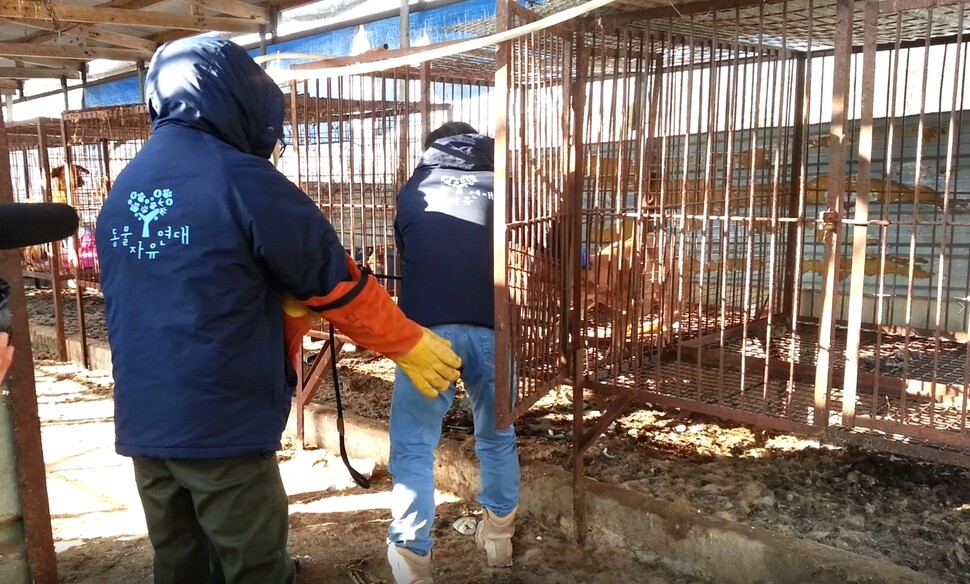hankyoreh
Links to other country sites 다른 나라 사이트 링크
[Special reportage-part I] Testing reveals high levels of antibiotics in dog meat

Slaughtering and eating dogs is a sensitive subject in South Korea. Even advocates of welfare for pets and farm animals have skirted the issue of dogs being raised for slaughter because that is how some farmers make a living and because dog-eating is considered a unique part of Korean culture. “Animal People,” a Hankyoreh publication dedicated to animals and life, is running a series of articles that will examine the current state of affairs and look into alternatives.
The owners of several dog farms that I met while researching this story over the past few months had a bone to pick with the media. There are a lot of clean farms with good facilities, they complained, but the media always visits ones that are dirty and poorly run. These owners believe that the media is out to make dog farming look criminal. But whether dog farms are clean or dirty, they all share a few traits: raised cages, cramped conditions, food waste and antibiotics.
All the typical traits of South Korean dog farms were on display at a farm in Yesan, South Chungcheong Province that I visited in July. As soon as I stepped into the farm, Tosa dogs, Jindo dogs and mixed breeds began barking all at once, making it hard to concentrate. Over 140 dogs were stuffed into elevated wire cages, which are suspended in the air so that the dogs’ droppings fall to the ground. These elevated cages measure about 1-2 meters on their length and width.
There was a hulking Tosa dog with a crooked back and bent legs. Two smaller dogs that were in the same cage were missing hunks of flesh, perhaps lost while scuffling with each other. Behind bars that were smeared with tufts of fur and excrement, puppies wriggled against their mother’s bodies. The mother, a small dog, bared her fangs and growled at people. Dogs instinctually feel secure when they are running along with their nose down, sniffing the grass and the earth, but their instincts are not taken into account in the elevated wire cage farming system.
A slop bucket was placed in front of the dogs in the cages. The slop was mostly food waste, with a little dog food mixed in. The slop and the dog’s body were swarming with dozens of flies. It was hard to say whether the rank and pungent stench came from the dogs, the slop, or the excrement below the cage. This was how another dog farmer explained the relationship between the food waste and the dogs: “We’re doing something that’s good for the world. These dogs are getting rid of all the food waste.”

Economic principles are also at work on dog farms. Costs must be minimized. The majority of dog farmers are registered as being in the food disposal business. The farmers feed their dogs food waste that they’re paid to collect, which costs them little but the time and effort of picking it up. But they have to ensure that their dogs don’t get sick from eating that kind of food. Sick dogs don’t turn a profit. Cramped conditions that go against dogs’ nature, unsanitary elevated wire cages and food waste leave dogs vulnerable to sickness at any time. So that’s why they’re fed antibiotics.
Eating dog is more likely to expose you to antibiotics than beef, pork or chicken. Between June and August, the Institute of the 3Rs at Konkuk University and the Korean Animal Welfare Association bought 93 portions of dog meat at 25 dog meat markets around the country (including Moran Market in Seongnam, Gyeonggi Province; Gupo Market in Busan; Chilseong Market in Daegu and Gyeongdong Market in Seoul) and tested the levels of residues from nine antibiotics. Residues from eight kinds of the antibiotics (including lincomycin, amoxicillin, enrofloxacin, tylosin and sulfathiazole) were detected in 60 portions of dog meat, representing 64.5% of the sample.
Let’s compare the situation to other livestock. Tests by the Animal and Plant Quarantine Agency’s municipal and provincial livestock testing agencies in the fourth quarter of last year found that antibiotics had been used on just 101 (0.44%) of 22,754 cows. The ratio for pigs was 383 (0.62%) out of 61,470, and for chicken was 31 (0.13%) out of 24,572. This means that antibiotic residues are found in dog meant 147 times more frequently than in beef and 496 times more frequently than in chicken. It also means that antibiotics are hardly ever used when raising cows, pigs and chickens, while the exact opposite is true about dogs.
Though the occasional dog isn’t fed antibiotics, its meat is still likely to be harmful to the human body. Every one of the 93 portions of dog meat that were inspected contained at least a total of 25 germs, viruses and other microorganisms. Some of these were dangerous, including the Proteus bacterium, which can cause diarrhea and urinary tract infection, and colon bacillus, which can sometimes bring on “hamburger disease” (hemolytic uremic syndrome).
“There’s a risk of bacteria causing infections in the gastrointestinal tract when you eat undercooked meat. The fact that various kinds of antibiotics [have been detected in dogs] is presumably the result of feeding them a cocktail of antibiotics [without the appropriate prescription]. This means that, when you’re eating or handling raw or undercooked meat, you could be exposed to antibiotic-resistant bacteria while making contact with dogs or their feces,” said Chae Yun-tae, a specialist in internal medicine and infectious disease at Hanil Hospital, on Aug. 24.
“This investigation verified suspicions that the syringes and medication that are often seen around dog farms are traces of the administration of antibiotics. Dog farms should now be addressed from the perspective of pet welfare, not farm animal welfare. The government needs to take steps to shut down dog farms,” said Cho Hui-gyeong, president of the Korean Animal Welfare Association.
Dog farmers don’t agree. A dozen or so dog farmers, vendors and other members of the dog meat industry who spoke with Animal People in July and August admitted the use of antibiotics but maintained that they don’t “overuse” them. They were also confident that they are independently producing safe food.
One dog meat vendor offered the following explanation about the state of “independent management”: “They’re not all necessarily fed antibiotics. First, they’re inoculated against respiratory diseases and intestinal infections. It’s just the farms where disease spreads because of poor management where [the dogs] are injected with antibiotics. That doesn’t mean they keep getting injected, though.”
The vendor went on to say that the dogs stop getting shots about three or four months before being sent to the slaughterhouse, since that’s when the antibiotic residue levels start to increase. “Since the dogs are healthy when they’re shipped out, there’s no need to inject them [with antibiotics].”
The Association of Korean Dog Farming Organizations offered a similar explanation. Since the dogs aren’t loaded up with antibiotics as they used to be, and since a drug-free period is maintained after administering medication, there are no safety issues with dog meat. Another reason that the use of antibiotics has decreased, the association said, is that dogs are slaughtered a little past one year of age, when they’re relatively healthy.
That still leaves some questions. Is it okay to eat a dog that has been injected with a small amount of antibiotics? Is there a way to run dog farms without using antibiotics? And why do we keep going to all this trouble to eat dog meat?
This series will be continued in Episode 2: The Dog Farmers
By Choi Woo-ri, staff reporter
Please direct questions or comments to [english@hani.co.kr]

Editorial・opinion
![[Column] Park Geun-hye déjà vu in Yoon Suk-yeol [Column] Park Geun-hye déjà vu in Yoon Suk-yeol](https://flexible.img.hani.co.kr/flexible/normal/500/300/imgdb/original/2024/0424/651713945113788.jpg) [Column] Park Geun-hye déjà vu in Yoon Suk-yeol
[Column] Park Geun-hye déjà vu in Yoon Suk-yeol![[Editorial] New weight of N. Korea’s nuclear threats makes dialogue all the more urgent [Editorial] New weight of N. Korea’s nuclear threats makes dialogue all the more urgent](https://flexible.img.hani.co.kr/flexible/normal/500/300/imgdb/original/2024/0424/7317139454662664.jpg) [Editorial] New weight of N. Korea’s nuclear threats makes dialogue all the more urgent
[Editorial] New weight of N. Korea’s nuclear threats makes dialogue all the more urgent- [Guest essay] The real reason Korea’s new right wants to dub Rhee a founding father
- [Column] ‘Choson’: Is it time we start referring to N. Korea in its own terms?
- [Editorial] Japan’s rewriting of history with Korea has gone too far
- [Column] The president’s questionable capacity for dialogue
- [Column] Are chaebol firms just pizza pies for families to divvy up as they please?
- [Column] Has Korea, too, crossed the Rubicon on China?
- [Correspondent’s column] In Japan’s alliance with US, echoes of its past alliances with UK
- [Editorial] Does Yoon think the Korean public is wrong?
Most viewed articles
- 1‘We must say no’: Seoul defense chief on Korean, USFK involvement in hypothetical Taiwan crisis
- 2N. Korean delegation’s trip to Iran shows how Pyongyang is leveraging ties with Moscow
- 3‘Weddingflation’ breaks the bank for Korean couples-to-be
- 4[Column] Park Geun-hye déjà vu in Yoon Suk-yeol
- 5Korea sees more deaths than births for 52nd consecutive month in February
- 6[Guest essay] The real reason Korea’s new right wants to dub Rhee a founding father
- 7[Column] The clock is ticking for Korea’s first lady
- 8[Column] Has Korea, too, crossed the Rubicon on China?
- 9Why Korea shouldn’t welcome Japan’s newly beefed up defense cooperation with US
- 10Will NewJeans end up collateral damage in internal feud at K-pop juggernaut Hybe?